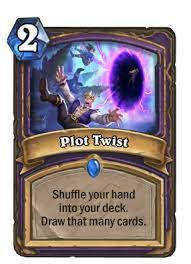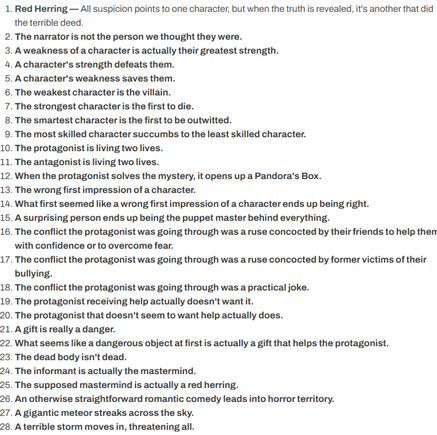
Education
This month's Aspire issue is all about believing. That's why we're going to be talking about plot twists – because they're all about what your readers do and do not believe!
Simply said, a plot twist is a surprise development in your story. A change that subverts the reader's expectations. When done well, you can really surprise your reader with a good plot twist, which will enhance their engagement with the story. Sometimes a plot twist is done so well that the reader can mull it over long after closing the book, which of course makes the story incredibly memorable.

Plot twists do not necessarily need to occur at the climax of the story. The only true rule for twists is that they cannot occur at the beginning of the story, because you need to lay some groundwork for it first. Careful setup of the rules and facts of the world you've created is important for an effective twist.
It is therefore equally important not too be too obvious about it. A twist needs to be unexpected. The reader shouldn't be able to guess at the twist before it has happened. However, the groundwork needs to be laid in such a way that, if the reader were to go back and re-read the first part of the book, they would be able to see the signs.
To this effect, foreshadowing is essential. Foreshadowing is a literary device in which you hint at something that will follow later in the story. This can create suspense and tension for the reader. But again, there is a fine line between using this literary device well and overusing it, which will make the plot twist become too obvious. Clues and hints should be used sparingly.
Another thing that's important to remember is that you shouldn't use too many plot twists in your story. A good, strong plot twist changes the direction of the entire story, so you only need a single big plot twist per story. Use more, and the reader will stop trusting you. The story will start to feel like cheap thrills without substance.

Plot twists shouldn't be there just for the sake of it. They should have an aim of their own. There are several reasons for which you could use a plot twist.
Firstly, a good plot twist can push the character to act. The middle of the story can sometimes feel like a bit of a filler part, with characters growing stagnant. By adding a plot twist, the character will come to face a sudden change of circumstances, which will force them to respond and take action. It might even change their ultimate goals.
Second, it can be used to reveal something important about the main character. For example, if the MC did something awful in their past, like killing someone, it would completely change the way the reader will look at them. If the MC turns out to be the antagonist's long-lost child, it could change everything for them, especially if they didn't know it themselves either.
Plot twists may also be used to create a false protagonist. This is a tricky one to do right, but definitely, a fun one to play with. In this type of story, you introduce a character seemingly as the protagonist, but then the character suddenly dies. A shocking plot twist for the reader! The real protagonist should already have been introduced at this point and should be ready and waiting to take over.

Let's look at some examples. Below are six types of plot twists that are relatively often used in storytelling. If you're struggling to come up with a good plot twist, one of these may fit your story well.
1. A character who the protagonist thought to be a friend, turns out to be a (or the) bad guy.
2. A plot point that seemed to be very important, turns out to be a red herring; a distraction from what's really going on.
3. After seemingly having resolved the main conflict of the story, a consequence of this becomes a turn of events leading to an additional obstacle (the main obstacle) to overcome.
4. Through some new piece of information, the reader finds out that the narrator is actually unreliable. (The Girl On The Train by Paula Hawkins is a magnificent example of this.)
5. Through a flashback or cutaway, the reader is shown a piece of important information that the characters do not have.
6. A new character is introduced to change the existing plotline.

To end this article, let's go over a few more tips and tricks for creating the best possible plot twists.
If you can't think of a good plot twist, consider the following tips. Firstly, let your characters create the plot twist. If your story follows the protagonist, delve into the antagonist and see if there's anything surprising they might do. Dive into the backgrounds of your characters to see if there's anything that might change the direction of the current story.
Another useful thing to try out is to approach your story as a reader. Put your story down for a while and come back to it with fresh eyes. Where is the plot taking you? What do you expect from the rest of the story? What kind of bomb could you drop to turn everything around and bring the plot in a new direction?
Remember that no one is safe. Any of your characters could meet their end (or another terrible fate) at any given moment. Consider whether you have a character that isn't crucial to the rest of the plot, and what the effect on your protagonist would be if they just... disappeared...
Once you have decided on a good plot twist, make sure it lands well. We've already mentioned the use of foreshadowing misdirection (red herrings) in the setup of a twist. Another thing to keep in mind is to make sure your plot twist is believable. While it should be unexpected, it should still fall within the range of possibilities of your story and the world you've created.
Another thing that can help in the setup of your twist is to create a subplot that means more than the reader might think. Subplots can create a perfect diversion (even a red herring) from the main plot, but when done right, they can also set up the twist. Perhaps the subplot ends up becoming the main plot. Or the subplot intertwines with the main plot in an unusual way. Or it distracts the reader so much, that they didn't see the plot twist in the main plot coming; you can hide your clues in the disguise of the subplot.
After the plot twist is revealed, make sure to keep up the momentum of the story. This isn't the end – it isn't even always the climax. Make sure that the story doesn't fall stagnant again after the big reveal, or the reader might grow tired. Your plot twist has very likely ramped up the tension so much, that the reader will be desperate to find out what happens next.
And lastly, it is good practice to test out your plot twist if you can. Find a beta reader to go through the story and see if they find the twist believable or whether they saw it coming. Beta readers can really help in finding that thin line between not enough and too much foreshadowing.
Finally, if you feel like your story needs a twist, but you're still not sure what your plot twist should be, you can always draw inspiration from the internet. There are almost endless lists of possible plot twists you can use in your story. Have a look around and see what fits your story. Take for example this list from Screencraft (https://screencraft.org/2020/09/09/101-plot-twist-ideas/).

As a final note, we'd love to hear any suggestions for topics we should cover next. If there's anything you struggle with in writing, let us know in the comments and we might just write an article about it soon.
Naomi - NDeMeer
Team Of Dreams

Bạn đang đọc truyện trên: Truyen247.Pro